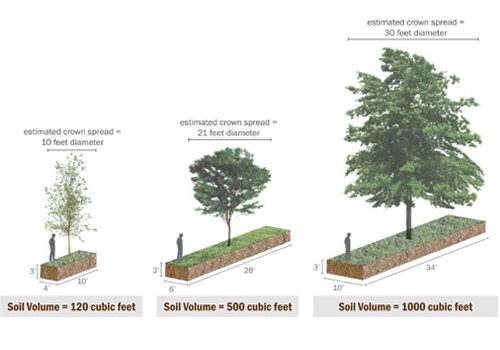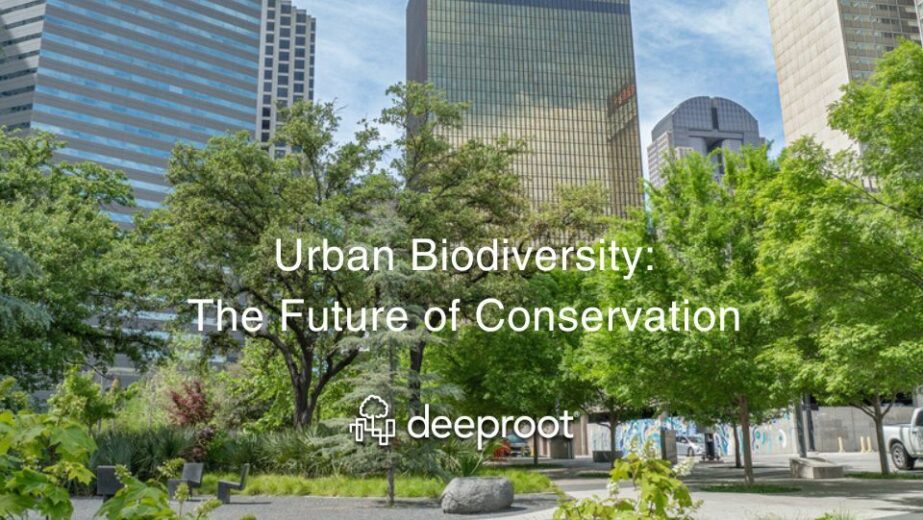To kick off 2012, we’re reprinting this great post written by Matthew Gordy for the Boston Society of Landscape Architects back in April 2011. One thing I love about this post is the theme of high performance. We plan and expect for high performance with other types of utilities and urban infrastructure because we want our money to go as far as it can. Why would we expect less for trees?
The urban forest is perhaps the most conspicuous example of contemporary urbanism’s heartthrob, green infrastructure; witness the preponderance of “Million Tree” campaigns such as MillionTreesNYC, Million Trees LA, the Chicago Trees Initiative and Grow Boston Greener. After all, trees are good, especially a million trees, right? It depends. The planting techniques for most urban trees lag far behind what is necessary to steward them to old age and impressive size.
The urban forest as green infrastructure, a primer
A robust urban forest produces myriad environmental, economic, social and cultural benefits, all while bolstering urban identity in ways no other infrastructure type can. As a biogenic public utility, it is unique in that it gains value over time rather than depreciating like most infrastructural assets.
The benefits of urban trees are well documented. Methods for assigning value to these benefits range from simple calculations, such as money saved on heating and cooling costs or increased property values to deeply contested and complex analyses. How does society determine the precise value, for instance, of the cleaner air and water or the increased biodiversity urban trees provide? The fields of environmental and ecological economics are hard at work creating metrics for such quandaries. At a minimum, it is widely accepted that the most important benefits the urban forest provides include a reduction of the heat island effect, improved stormwater management (which means higher water quality and reduced flooding), reduced air pollution, reduced energy use, increased property values, increased wildlife-habitat potential and a range of heightened aesthetic and spatial qualities.
Trees are remarkable biological machines that perform astounding feats of structural assembly and adjustment, self-defense and maintenance, organic chemistry, water pumping, atmospheric manipulation and power generation. The productive capacity of a tree increases in magnitude as it gets larger, and this is the key to understanding another maxim of urban trees: In terms of environmental and economic performance, bigger is better, by a long shot.
The Center for Urban Forest Research calculates that large-canopy trees (greater than 50 feet in height and canopy spread) outperform small trees (less than 25 feet) by a factor of 15, and they do not start adding significant environmental performance until they reach 30 feet. Trees that do not reach this minimum will never be more than an aesthetic amenity. In the quest to make the urban forest into a high-performance green infrastructure, lots of big trees are required, especially in the most environmentally compromised zones: streets, plazas, parking lots, and commercial strips. These places have two things in common that make them hostile to trees: more than 90% impervious surface cover—what I like to call “extreme pavement”—and highly compacted soils.
An underground movement: soil resources
To grow large trees in the harshest urban conditions, a literal underground movement is necessary, and it’s all about the soil. Tree roots cannot penetrate the compacted soils of the urban environment; they need soil with lots of pore space and, ideally, organic matter. When a tree’s roots run out of space prematurely, one or more of the following happens: 1) The tree stops growing, 2) space-starved roots shove pavement and curbs aside in desperation and 3) the tree dies or is removed. Tree roots can and will break pavement, yet they cannot penetrate compacted soil. Because typical tree-root growth is relatively shallow and spreads laterally, roots need room to spread out. The eventual size and longevity of a tree depends on its ability to do that.
A graph developed by landscape architect James Urban plots tree size, measured in crown spread and trunk diameter at breast height (DBH), as a function of available soil volume, measured in cubic feet. To grow a tree that achieves the minimum size for significant environmental performance, 800 cf of soil is required. A typical planting detail specifies a 4 feet by 10 feet tree pit (that is only 120 cf of soil!) carved out of highly compacted soil and surrounded by pavement. Trees planted in these conditions will be lucky to reach 15 feet in height, and the stormwater processing capabilities of that soil are negligible. High-compaction soil and extreme pavement are the dual enemies of urban tree growth and on-site stormwater management. Retooling underground infrastructure to accommodate high-quality, uncompacted soil enables the growth of large-canopy trees and the absorption of large volumes of stormwater.
Techniques to maximize soil
In pursuit of soil volumes required to grow environmentally productive urban trees (various experts recommend between 700 – and 1,000 cf), several techniques can be used that rely on the inventive use of space and augmented construction methods. Space permitting, the easiest way to achieve target volumes is an open planting area (1,000 cf = 10 feet by 34 feet by 3 feet tree pit, for example.) Since this is usually not possible in heavily paved areas, augmented techniques using covered soil in combination with open soil can be used. These include the use of root paths (narrow trenches of uncompacted soil under pavement to connect the planting area to nearby volumes of soil), structural soils and suspended-pavement systems.
CU-Structural Soil™, developed by Professor Nina Bassuk and colleagues at Cornell University, solves the compaction problem by mixing angular one-inch crushed stone with planting soil, at a stone-to-soil ratio of 4:1. The stone pieces form a load-bearing “rigid lattice” that leaves space for uncompacted soil. CU-Structural Soil outperforms compacted soil, but the large proportion of stone in the mix means that 80% of the space is unavailable for root growth and water storage. Claiming a higher percentage of that space would boost performance.
Suspended-pavement systems offer the best combination of structural strength and large volumes of quality soil. A suspended-pavement system consists of an underground post-and-beam structure and a deck with pavement on top. The structure supports the weight of the pavement and additional loading by pedestrians and vehicles, leaving the space for large volumes of uncompacted soil for root growth and storm-water treatment. This approach also protects pavement and curbs from the rogue roots of cornered trees; they will always prefer expanding into tasty soil over pavement demolition. Storm water can be allowed to infiltrate the soil in several ways, such as via permeable pavements, drainage slots, curb-cut inlets and sheet flow to open planting areas.
Providing that much high-quality soil opens the door to a much larger selection of species beyond the 10 or so that can survive in hostile urban soils. A greater mix of species helps fight pests and disease, and increases urban-habitat potential. This expanded planting palette may be one of the most significant ways to ensure the viability of the future urban forest.
San Francisco–based Deep Root Partners introduced its suspended-pavement system Silva Cell in 2007, and there are already hundreds of installations internationally, but performance data for mature trees is at least a decade away. Improvements in stormwater treatment can be measured immediately, however, and the benefits are clear. An installation in downtown Minneapolis intercepts stormwater for 6.6 acres with 179 trees planted in Silva Cells. Suspended-pavement systems are not new, and one of the best case studies is in Charlotte, North Carolina, where, in 1985, 170 trees were planted using custom suspended pavement along a 10-block stretch in the downtown business district. Each tree received 700 cf of soil, and the results have proved stunning. A 2009 survey found that the trees (167 of the 170 survived) have thrived, reaching an average height of 44 feet and 16 inches DBH.
The Achilles heel of suspended pavement is its high initial cost, adding as much as $10,000 per tree to install compared with conventional methods, a figure that will give pause to many! A life-cycle cost calculation goes a long way toward justifying this investment, and, in some cases, savings in up-front costs for traditional infrastructure can pay for it many times over. For instance, the City of Minneapolis chose a $1.5 million Silva Cell installation over a $7.5 million storm-sewer upgrade to meet the city’s storm-water goals. Still, the cost threatens to put suspended pavement out of reach for many smaller projects and out of the question for some private developers.
Although many cities are writing minimum soil-volume standards into their zoning codes, cost is still a barrier. In Brookline, Massachusetts, the urban forestry budget is now part of the Capital Improvements Program, typically the domain of infrastructure construction and maintenance. By elevating the urban forest to public-infrastructure status, new funding possibilities emerge to offset the costs for suspended-pavement and other soil-intensive planting techniques. As a hypothetical, a city’s Department of Public Works could purchase materials and supplies such as Silva Cell in bulk and provide them at little or no cost to new projects that achieve stated environmental goals. As in the Minneapolis experience, the cost savings to the city could easily pay for such a program.
What about those million trees? Although a million is a great public-relations sound bite, the absolute number is not nearly as important as the quality of the plantings. Many trees will undoubtedly be planted in parks and open spaces where soil conditions are favorable, but thousands of trees are bound for those tough streets and parking lots. In that case, 100,000 healthy, large trees trumps 500,000 struggling or dead trees in every way. I, for one, hope that the program managers direct their resources to make this happen.
Matthew Gordy is an Assistant Professor in the Landscape Architecture department at Iowa State University.







Excellent article. Great overview of some basic elements of designing the urban substrate with some specific recommendations as to how. Thanks from a landscape architecture student studying soil as urban infrastructure for thesis work.